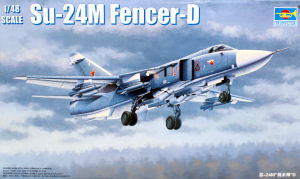
Trumpeter 1/48 Su-24M Fencer D Kit First Look
By Michael Benolkin
| Date of Review | February 2010 | Manufacturer | Trumpeter |
|---|---|---|---|
| Subject | Su-24M Fencer D | Scale | 1/48 |
| Kit Number | 2835 | Primary Media | Styrene, White Metal |
| Pros | First kit of this aircraft in 1/48th scale and best kit of the subject in any scale | Cons | Nothing noted |
| Skill Level | Basic | MSRP (USD) | $149.95 |
First Look
 |
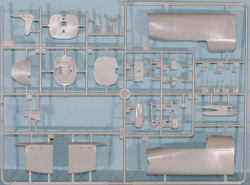 |
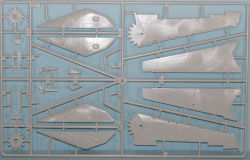 |
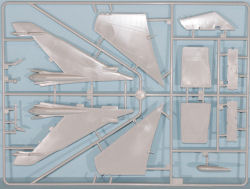 |
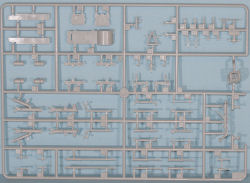 |
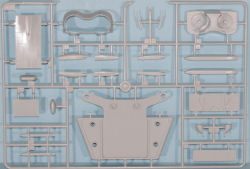 |
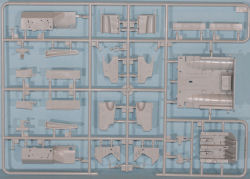 |
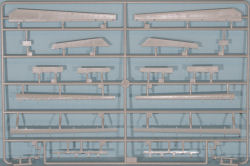 |
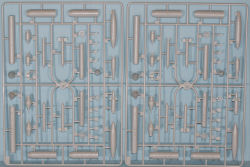 |
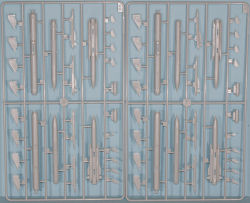 |
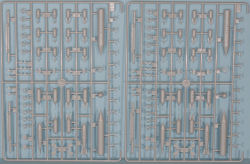 |
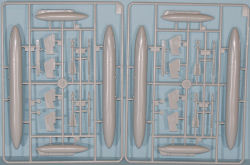 |
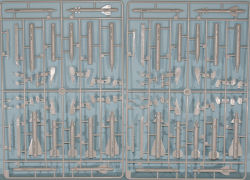 |
 |
 |
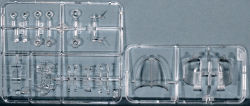 |
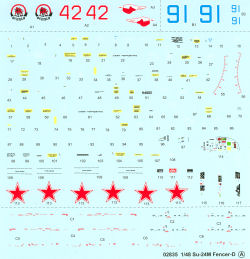 |
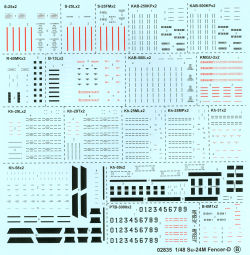 |
The Sukhoi Experimental Design Bureau (OKB) was the principal developer of tactical strike aircraft for the Soviet Tactical Air Armies with the Su-7 (NATO Codename: Fitter A) becoming the workhorse in the air-to-ground arena in the early 1960s. While the Su-7 was a rugged fighter-bomber, it lacked the ability to operate from shorter airfields due to its sharply swept wings and it was only effective in day/VFR conditions. Sukhoi tackled the problem from two directions.
To tackle the all-weather capabilities, the Sukhoi OKB worked with OKB-794 in the development of the Puma advanced navigation and attack avionics suite. About the same time, the Central Aeronautics Institute had several of the OKBs working on short take-off and landing (STOL) concepts using lift engines to augment lift at low airspeeds.
Sukhoi developed the T-6 testbed that were powered by a pair of afterburning main engines and four lift engines. While the testbed did achieve its STOL objectives, it was a bear to handle in before full wing-borne flight speeds were achieved and the excess weight of the lift engines took away much-needed fuel capacity.
In parallel with the T-6, the Sukhoi OKB was also trying to make it easier to get the Su-7 in and out of shorter fields as well as improve its payload. The Su-7I testbed replaced the swept wings with half-span variable geometry wings which could sweep back to the Su-7's standard cruise angle, but then sweep forward to near perpendicular to the fuselage for take-off and landing. The concept was very successful and the Su-17 and Su-22 Fitters replaced the Su-7 in frontline service.
By 1968, Sukhoi OKB was given the green light to abandon the lift engine approach and the T-6 airframe was reconfigured to incorporate a similar variable geometry wing layout that the MiG OKB also used with the MiG-23 and MiG-27 (NATO Codename: Flogger). The Puma system was incorporated into the airframe with the pilot and bombardier/navigator seated side-by-side to manage the system. The resulting T-6-1 testbed proved successful and the aircraft was accepted into service as the Su-24 (NATO Codename: Fencer).
There was naturally a lot of excitement when test shots of this kit started appearing around the internet. With the exception of the Zvezda/DML 1/72 releases of this subject, nobody has really paid attention to this Soviet strike aircraft. What's more, this is the first kit that has appeared after the barriers between east and west came down and much-needed detail information became available.
This kit is molded in light gray styrene and presented on 23 parts trees plus separately packaged fuselage halves and radome. Two trees of clear parts, one set of white metal landing gear struts, and a set of rubber tires round out the kit. According to the kit specifications, there are 697 parts in the box.
As with any good aircraft kit, construction starts in the cockpit. The first step assembles the two 11-piece K-36D ejection seats and these are the nicest K-36Ds I've seen in styrene to date, though I'm not too convinced by the molded-in harness details molded into the seat cushions. These will no-doubt be replaced by some color photo-etch from Eduard in the coming months.
The main instrument panel is provided as a clear part with bezels and lenses molded onto the surface. Simply mask the lenses, paint the panel, and add the decal with the instrument faces behind the panel and you're good to go. If this approach isn't sufficient, you can expect a color photo-etch panel to accompany the K-36D harnesses from Eduard.
The cockpit is nicely laid out and will look just fine straight out of the box. The cockpit tub mounts atop the nose gear well and the twin-wheel nose gear with splash deflector is also really well done. The white metal gear will really add some strength to what will be a heavy model.
There is a double bulkhead that mounts to the front of the cockpit tub and this houses a movable air refueling probe. The tub/well/bulkhead assembly go into the nose halves.
While you're at it, you'll add the spraybar/flame holder details into the afterburner chambers that mount into the rear tail section. The details look good here and absent are any of the strange compressor/turbine blade designs we've seen in past releases.
Next comes the assembly of the multiple radar dishes that go onto the forward bulkhead. You'll definitely want to pose the radome off and see this nice detailing!
The main gear struts are styrene with white metal cores for strength. The kit captures the unique twin-wheel trailing link gear design.
The main gear well comes next and there is some good detail in here, but then you flip the well over and add the wing sweep mechanism. This assembly goes into the main fuselage halves along with the afterburner/tail cone assembly.
The wings are next and the instructions show you how to pose the flaps and slats extended as well as the spoilers deployed. Warning: The instructions don't show you how to assemble the wings with the flaps/slats up and spoilers closed which is what you'll want if you make use of the wing sweep capability. You'll need to make a choice here that isn't in the instructions, down and dirty, or clean and sweepable? The outboard pylons do not pivot with the wings in the kit (they do in real life) so you may want to omit these if you do opt for movable wings.
The forward and main fuselage sections come together along with the wings, intakes, stabilators and vertical stab. The rest of the effort is spent adding antennas, pylons, cooling scoops, speed brakes, chaff/flare launchers, etc.
So what are the features of this kit:
- Detailed cockpit
- Clamshell canopies can be posed open or closed
- Very nicely done landing gear
- Detailed wheel wells
- Detailed radar
- Good afterburner section details
- Movable air refueling probe
- Movable wings (see warning above)
- Radome can be removable (extra engineering may be required)
- Slats can be posed up or extended
- Flaps can be posed up or extended
- Spoilers can be posed up or closed
- Rudder is posable
- Stabilators are posable
- Speed brakes can be posed open or closed
- Nice IR jammer
- Chaff/flare launchers
If you haven't noticed yet, this kit comes with an awesome selection of external stores and you'll be able to arm up most of your 1/48 Soviet-era fighters with the left-overs that you don't use in building this model. This is by far the best selection of 1/48 Russian/Soviet air-to-ground stores in one box I've seen to date. Included in the box:
- 2 x external fuel tanks
- 2 x sensor pods
- 4 x multiple ejector racks (MERs)
- 4 x R-60 (AA-8 Aphid)
- 6 x AB-250 bombs
- 2 x ZB-500 stores
- 2 x FAB-500 bombs
- 4 x S-24 rockets
- 2 x S-250FM rockets with three warhead options
- 4 x B-8M rocket pods
- 2 x B-13L rocket pods
- 2 x KAB-500L laser-guided bombs
- 2 x KAB-250KP EO-guided bombs
- 2 x KAB-500KP EO-guided bombs
- 2 x KMGU-2 dispensers
- 2 x Kh-25ML (AS-12 Kedge)
- 2 x Kh-25MP (AS-12 Kegler)
- 2 x Kh-59 (AS-13 Kingpost)
- 2 x Kh-29L (AS-14 Kedge)
- 2 x Kh-29T (AS-14 Kedge)
- 2 x Kh-31 (AS-17 Krypton)
The kit provides decals for two subjects:
- Su-24M, Bort 42, Russian Air Force
- Su-24MK, Bort 91, Russian Air Force
The kit comes with two sets of decals. The first comes with the distinctive markings and a nice selection of airframe stencils. The second sheet provides stencils for all of the weapons in the box.
At last, we have the Su-24M in 1/48 scale and I don't think there are many stores options for the Fencer that aren't included in this box. As I said above, you'll have plenty of extras left over to bomb up your Monogram Su-25, Kopro Su-22, Italeri/ESCI MiG-27, Academy Su-27, etc.
As with other recent releases, you won't see any evidence of the 'mad riveter' as all of the surface details are fine and crisp. I'm a bit puzzled why the kit would have you pose the flaps and spoilers deployed with a working wing sweep mechanism as you'll be knocking off parts the first time you cycle the wings. It is nice to have the option for 'down and dirty' or movable wings, but the instructions might do better to explain how to do either configuration.
Despite that minor oversight, this kit looks great and will build up into the best Fencer released in any scale to date.
My sincere thanks to Stevens International for this review sample!







